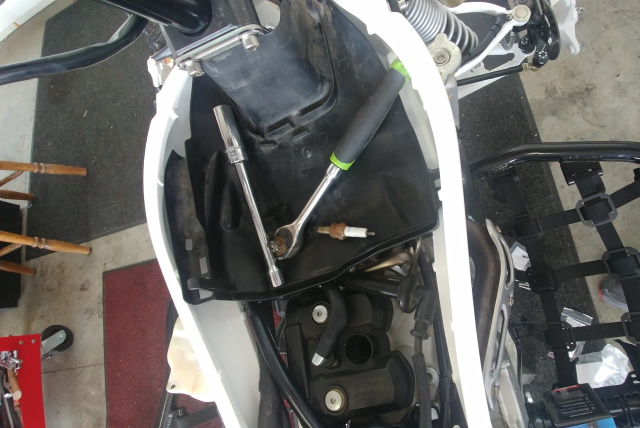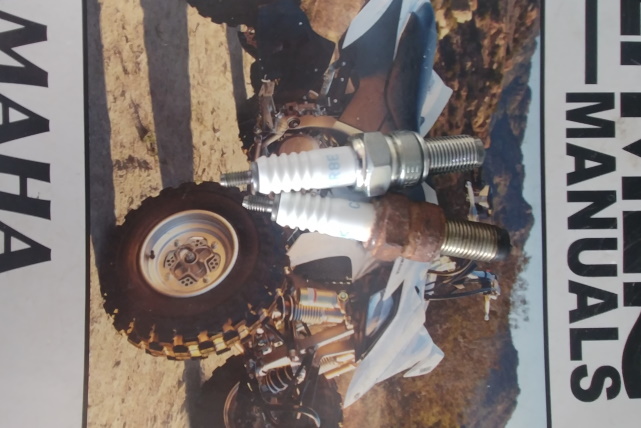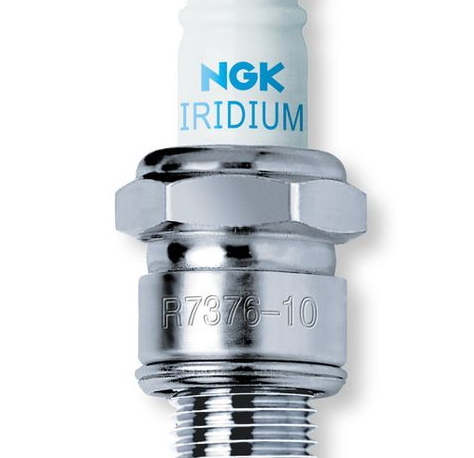
The oddest looking part on your ATV turns out to be one of the most important.
The spark plug on your ATV not only starts the engine but keeps it running by maintaining a continuous spark firing once per full revolution on a 2-stroke and every other full revolution on a 4-stroke.
Fun Fact: One stroke is half a revolution thus the term 4-stroke.
The spark plug often fails because of neglect. Basically you forget about it! Checking the spark plug on a 4-stroke ATV requires the removal of the gas tank often giving way to postponing inspecting and replacing per suggested service intervals. A 2-stroke ATV offers a much easier opportunity to visually check and replace the spark plug because it sits out in the open on the cylinder head. Also, just to get at the spark plug on a 4-stroke ATV you typically need a six- to eight-inch inch socket extension. On a 2 stroke you can simply access it with an open ended wrench. In either case, spark plugs foul after burning up or getting full of soot from oil, always, it seems at the most inopportune time.
ATV spark plugs cost as little as $4 or as much as $40 (depending on make, model and year of your ATV) but whatever you pay spark plugs generally last a long time especially on 4-strokes. That should not excuse putting off a visual check. A proactive maintenance routine includes a spark plug check which can prevent a no-start down the line usually far from camp or right before a gate drop. It's good practice to carry an extra spark plug, or two, along with a gap tool (more on that later) and spark plug removal tool. It's one thing to have the spark plug it's another to have the tools necessary to remove the old one and install the new one. Spark plugs on a 4-stroke might be hard to reach but at least you won't be left stranded.
Mechanic's Tip: When riding a 2-stroke ATV pay attention to drastic changes in elevation from one ride day to the next or even that day. Air density changes with changes in elevation which can result in less air and more fuel and oil in the cylinder fouling the plug. Fuel-injected 4-stroke and 2-strokes self-calibrate and don't have this issue.

When to Change ATV Spark Plug
4-Stroke ATV Spark Plug
Use the service interval listed in the owner's manual of your 4-stroke ATV otherwise change the spark plug once a year or so as a mostly weekend rider. Anytime you need to rebuild the engine replace the spark plug, too.
2-Stroke ATV Spark Plug
Granted you might have a hard time finding a 2-stroke ATV but they do exist and have an almost cult following. The oil mixed into the gasoline for 2-strokes fouls out the spark plug faster than a 4-stroke, depending on carb tuning. If you tune the carb rich, this fouls the plug faster so routine spark plugs checks prevent future issues. And, since you have easy access to the spark plug you really have no excuse if you get stranded because of a fouled spark plug.
Mechanic's Tip: Don't run lean either because you can burn a piston.

When checking the spark plug on your ATV look at the color of the electrode. It turns white when running too lean, turns black when too rich, or (hopefully) brown when running just right.
ATV Spark Plug Number
You cannot install any type of spark plug in your ATV. Like motor oil, specific spark plugs work best in one make, model and year vs. another MMY. If you think the more expensive the better, you might just waste your money. Indeed, some MMY ATV require a specific and pricey spark plug while another you can get away o the cheaper side. Therefore, consult the owner’s manual for the best spark plug that fits the MMY of your ATV and go from there.

ATV spark plugs have a numerical number that looks similar to "B8ES" or "BKR7EIX" depending on the spark plug manufacturer. Use that number to determine best fitment. Higher number spark plugs run cooler and you can get plugs as low as "5" or as high as "10." Swap out the lower number spark plug you run in the spring with a higher number spark plug for the engine. The ATV owner's manual tells you the ideal spark plug number for the time of year and even geographical location.
The rest of the numbers on the spark plug reference the length of the plug, thread size and type of electrode. Different style electrodes make for a cleaner spark which results in a more complete fuel burn plus other benefits.
ATV Spark Plug Gap
The spark plug gap refers to the space between the center and side electrodes. The plug won't fire if the gap is too big, conversely, too small of a gap ignites the plug too soon resulting in missing the right time on the stroke to fire at compression. Incorrect gapping also causes higher engine temps. An ATV spark plug correctly gapped fires at the right time and provides optimal fuel burn per stroke. You need a spark plug gap tool to determine proper gap and ATV owner's manual explains the appropriate gap (0.5mm, 0.6mm, 0.7mm and so on) for the MMY of your ride. Rough shipping or you mishandling the spark plug can change the gap so use the gap tool close or widen the gap, if necessary.

How To Change an ATV Spark Plug
The cylinder head holds the spark plug which you remove by using a proper fitting socket wrench. A spark plug wrench offers the necessary depth needed to fit the socket over the electrode and around the spark plug fitting to loosen it so you may find that works better than something from your garage. You can remove a spark plug on a 2-stroke ATV in less than a minute because you don't have to remove other parts to get to it unlike a 4-stroke ATV that requires removing the gas tank.
How to Remove ATV Spark Plug
First, pull of the cap and remove the wire. Now use the socket wrench to remove the spark plug. Replace with the new spark plug and make certain you line up the threads before tightening. You have to replace the cylinder head if you strip the inside threads. But, more commonly, ATV owners over-tighten the spark plug and break it off inside the cylinder head. Now you're in trouble! You won't ruin the cylinder head but the time and overall pain involved in trying to remove the broken plug keeps you from ever doing it again. Most owners tighten by feel but you can use a torque wrench to seat the spark plug. Whatever method you use, don't over-tighten!
Check out all of our ATV spark plugs.





